Experience the ultimate high-altitude adventure with the Mürren Via Ferrata to Gimmelwald trail in the Swiss Alps. Starting from the serene and car-free village of Mürren, this exhilarating mountain route takes you on a winding journey along breathtaking cliff faces, across the world-famous “Nepal Bridge”, and eventually to the charming village of Gimmelwald. As you traverse the trail, you’ll be treated to unobstructed views of the iconic Alpine peaks, making this Via Ferrata experience truly unforgettable. And don’t worry, safety is a top priority – you’ll be securely strapped in with a harness as you climb ladders and steps on the edge of the cliff overlooking Lauterbrunnen.
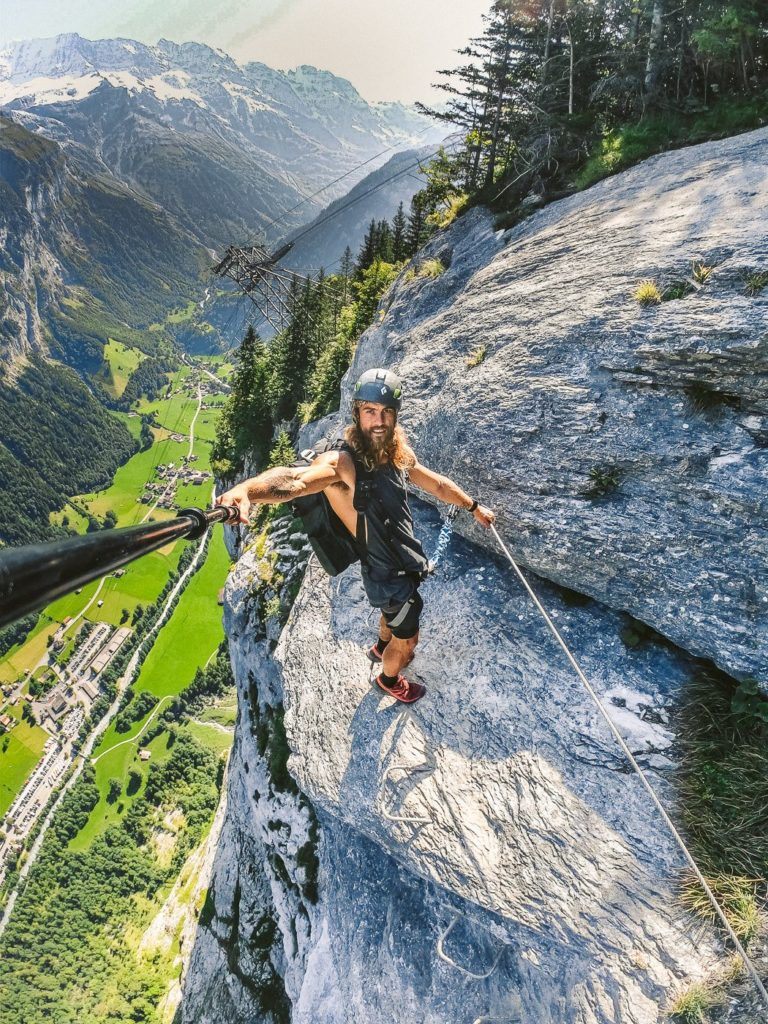
Mürren Via Ferrata To Gimmelwald
Whenever anyone is in the Jungfrau region, I always suggest they try the Mürren Via Ferrata to Gimmelwald. It’s such a unique adventure that gives you a high-adrenaline activity in quite a safe way. In this blog post, I’ll tell you everything you need to know about doing the Mürren Via Ferrata such as, how to get there, and what gear you need!
There’s an awesome 3-DAY Via Ferrata Tour in Switzerland completely dedicated to via ferrata. It takes you on a new and challenging via ferrata each day and includes all accommodation, gear, food UIAGM Guides and transport throughout the trip. You can Click Here to check out the details of that tour.
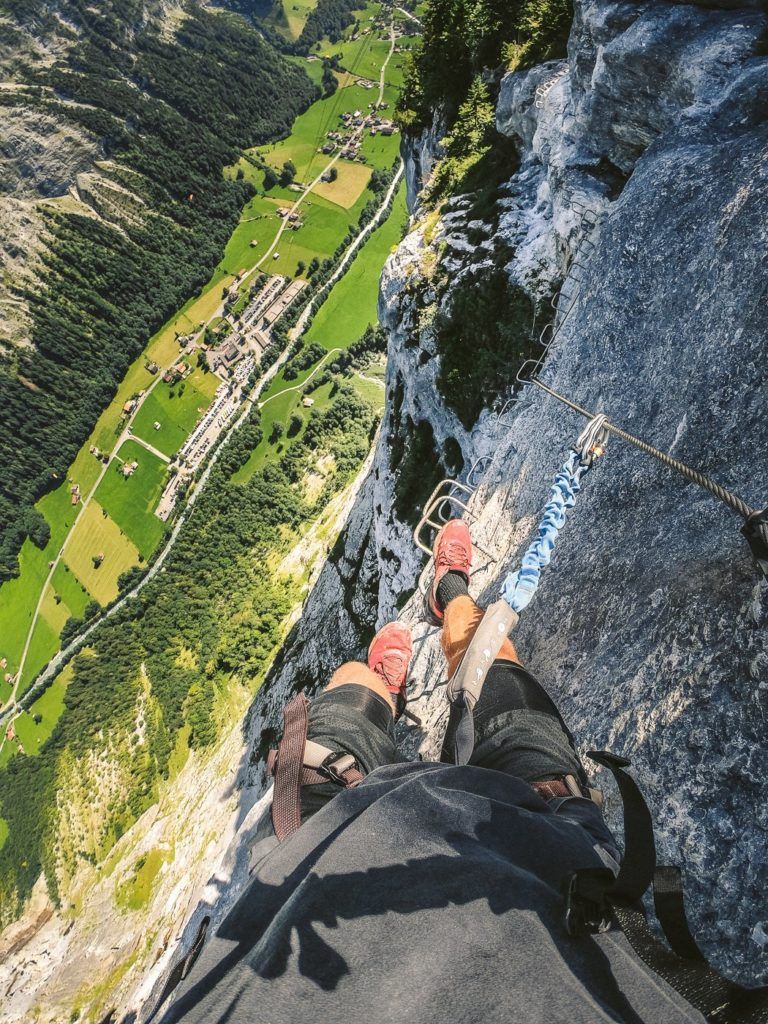
MÜRREN VIA FERRATA: THINGS TO KNOW
- Starting Point: The starting point for the Mürren Via Ferrata is next to the Sportchalet in Mürren, which is where you will find the clay tennis courts. It is also directly across from Intersport, which is where you will likely hire your gear. You then follow the signs that say Klettersteig, as they lead you down a path through the town and then into a tunnel. The cable starts at the end of the tunnel.
- Ending Point: The end of the Mürren Via Ferrata is in Gimmelwald. It ends right at the Schilthornbahn station so you can either cable back down to Stechelberg or up to Mürren to return your gear.
- Length: The entire Mürren Via Ferrata is 2.2km in length with several lengthy sections, which are pretty much just a hiking trail.
- Duration: I did this trail in 1.5 hours but could imagine it would take others up to 3 hours especially if you are in a bigger group.
- Difficulty: The Mürren Via Ferrata is rated as a K3 difficulty, which is on a scale of K1- K6
- Cost: Like all of the via ferrata’s in Switzerland it is free unless you need to hire your gear. The route itself is free to enter.
- Guide: You don’t need a guide but if it is your first ever via ferrata I suggest you take one just to learn the basics. Engaging in this activity is generally safe, but it can become extremely hazardous if you make errors while setting up your equipment or experience panic while standing on the edge of a cliff.
To give you an idea of what you are in for, here is my highlight video:

HOW TO GET TO THE MÜRREN VIA FERRATA
The via ferrata is located in Mürren, which is a car-free town. The best way to get there is by cable car from down in Lauterbrunnen, which you can reach by car or train. Depending on where you are coming from the route will be slightly different. I came from Interlaken and the entire journey took about 1.5 hours.
- From Interlaken, you will need to catch the train Lauterbrunnen
- Once in Lauterbrunnen take the Grutschalp cable car, which is right next to the train station. This will take you all the way up to Grutschalp station where you can switch onto the historic, Mürren Railway.
- The Mürren Railway is one of the most scenic rides in Switzerland with views of Eiger and the surrounding peaks along the journey.
- Once you arrive at the Mürren Train Station turn left out of the station and walk for 10 minutes past Hotel Edelweiss and you will arrive at the sports chalet on your right and Intersport on your left for the hiring of the gear.
If you have the Swiss Half-Card you will receive a huge discount on your tickets. I bought mine when I arrived in Switzerland and it has saved me over a thousand dollars throughout my trip.
GET A SWISS TRAVEL PASS!
Enjoy UNLIMITED train, boat, and bus rides in Switzerland for up to 15 days. Click to book a flex Swiss Travel Pass or choose the Consecutive Swiss Travel Pass.
The Swiss Travel Pass starts at $260 for 3 days. Click here to check if it’s available on your travel dates.
WHAT IS A VIA FERRATA
A Via Ferrata, Italian for “Iron Path,” is a protected climbing route found primarily in the Alps, but now can be encountered all over the world. The concept was first developed in Italy during World War I to facilitate troop movement across the rugged Dolomite mountain range. Today, they provide adventurous outdoor enthusiasts with an exciting way to experience the high alpine environment.
A Via Ferrata consists of a series of iron rungs, pegs, ladders, and cables fixed to the rock, creating a pathway that allows non-expert climbers to traverse steep and difficult terrain that would otherwise require advanced climbing skills. Additionally, there’s a steel cable that runs alongside the route, to which climbers can attach themselves with a special via ferrata harness for safety.
While Via Ferrata routes vary in difficulty, all require a good head for heights, a moderate level of fitness, and some essential equipment, including a helmet, harness, and a special via ferrata kit like this one: Petzl Via Ferrata Kit. They offer a unique way for people to access spectacular mountain landscapes, and enjoy the thrill of rock climbing without the need for extensive training or experience.
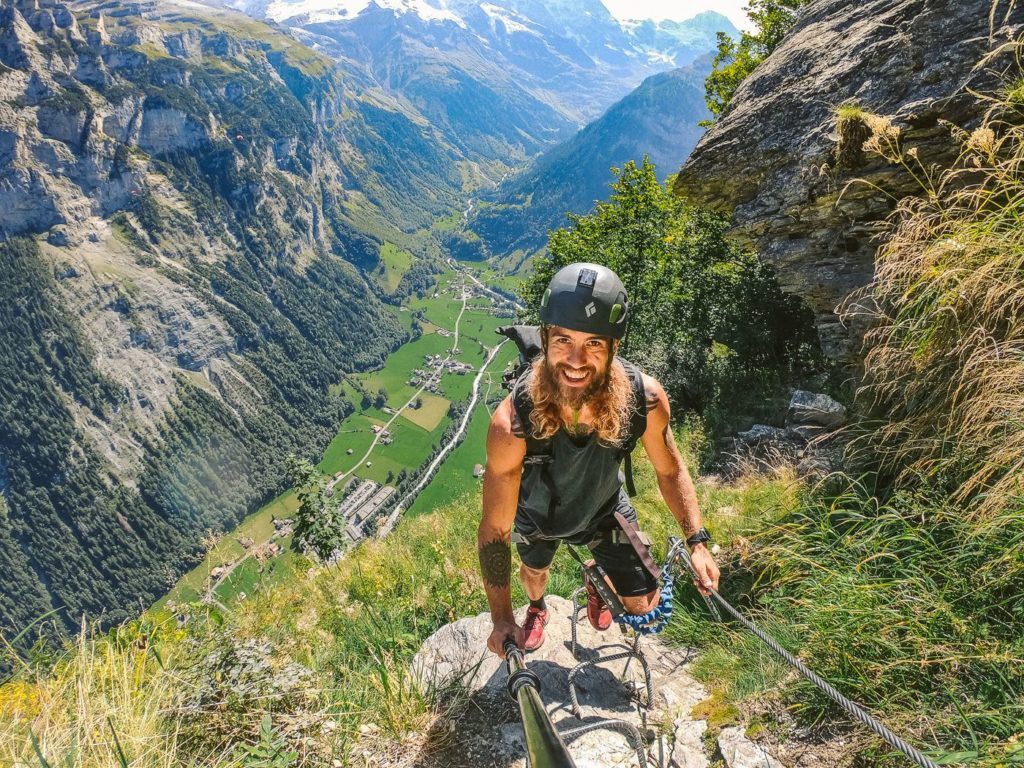
DO YOU NEED EQUIPMENT
You can actually buy your own Via Ferrata gear for pretty cheap on sites like Amazon and then you don’t need to rent it at each Via Ferrata course. They usually cost about $20-40 USD to rent per day and can be bought for about $200 for a full kit such as this Petzl Via Ferrata Kit.
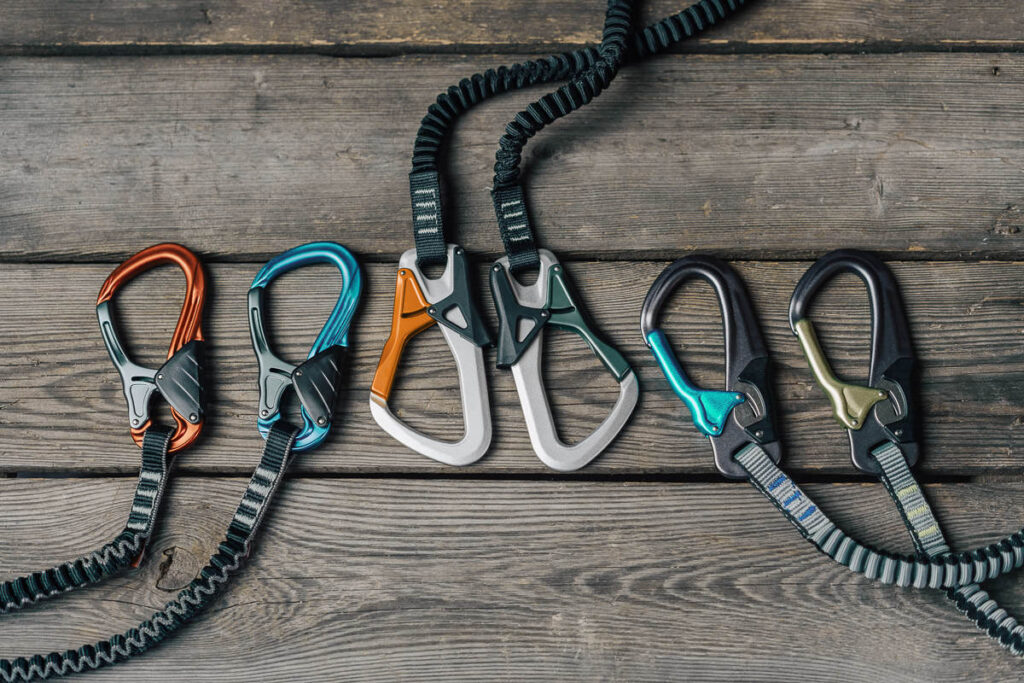

WHERE TO RENT YOUR GEAR FOR THE MÜRREN VIA FERRATA
To do the Mürren Via Ferrata you will need a helmet, harness, and carabiners. It is advised to wear shoes with good grip and many people opt for gloves.
However, the only real requirement for gear is the helmet, harness, and carabiners. If you have all the gear you are good to go. If not, you can rent it for around 25-35 USD at Intersport in Mürren. I rented it from here and they were helpful and even offered to rent out Salomon hiking shoes if I wasn’t comfortable in my trail shoes. After the via ferrata you need to return your gear to the Mürren Store.
MY MÜRREN VIA FERRATA VLOG

MÜRREN VIA FERRATA TO GIMMELWALD: MY EXPERIENCE
I began my day in Interlaken and took the train to Lauterbrunnen, transferred to the Grutchsalp cable car and then finally rode the train to Mürren from Grutschalp. I think my transit to Mürren might have been equal to the time I was on the via ferrata!
After walking my way down to Intersport, I hired my helmet and harness for $25 USD and the lady pointed me across the road to the sports chalet. I followed the Klettersteig signs for a couple of turns before I arrived at a small tunnel, which was more or less the starting point of the Mürren Via Ferrata.
Once on the other side of the tunnel, the cable was there on the left and it was time to clip in with the carabiners. The via ferrata started off with very low difficulty, likely for guides and instructors to use the first 100m as a warm-up for beginners.
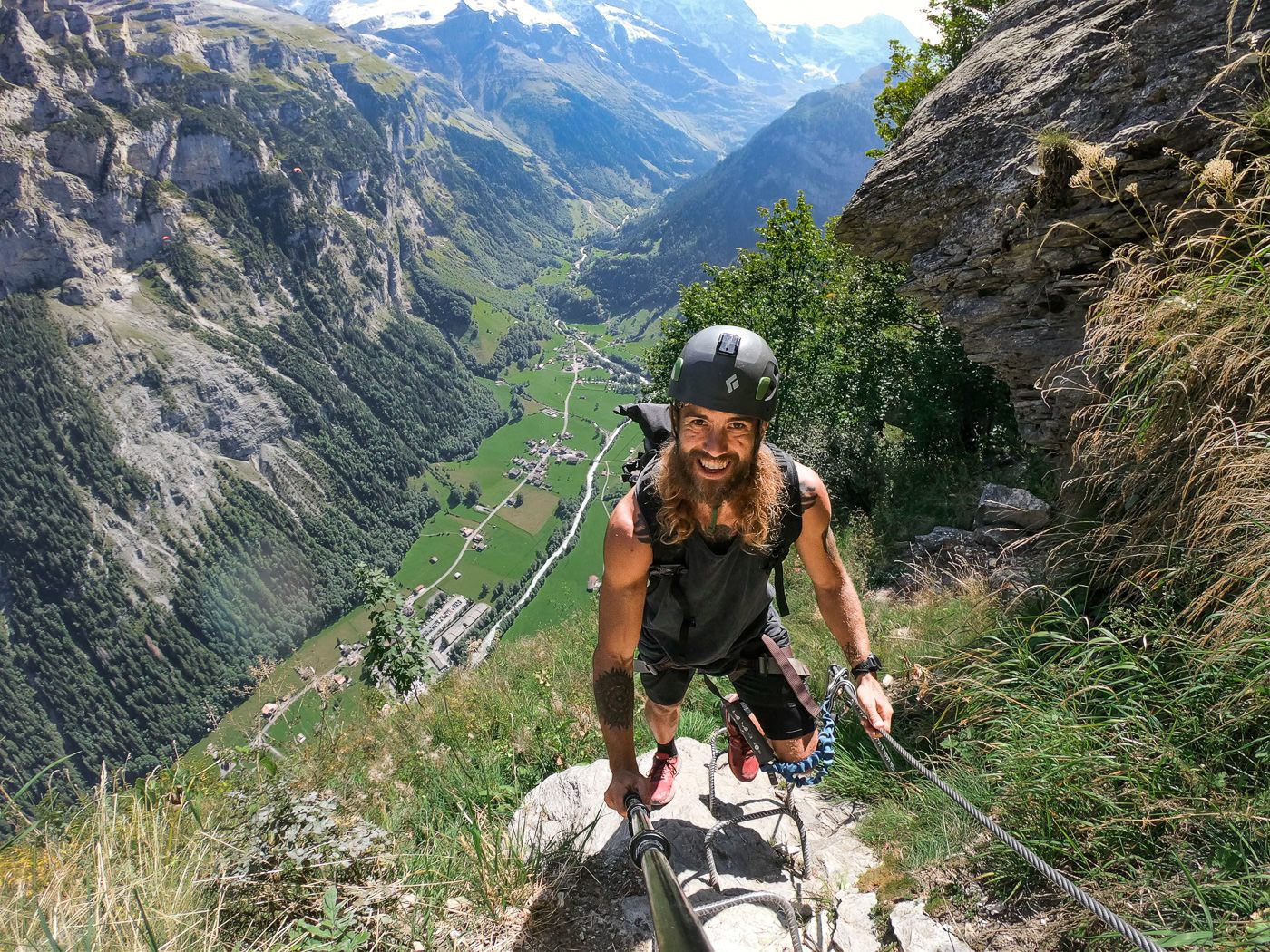
However, there were many parts where the via ferrata was less dangerous than most hikes I’ve been on in Switzerland. During those parts, it is a little tiring clipping in and clipping out every few steps when you are just walking on a flat path. Nevertheless, there were some epic moments also.
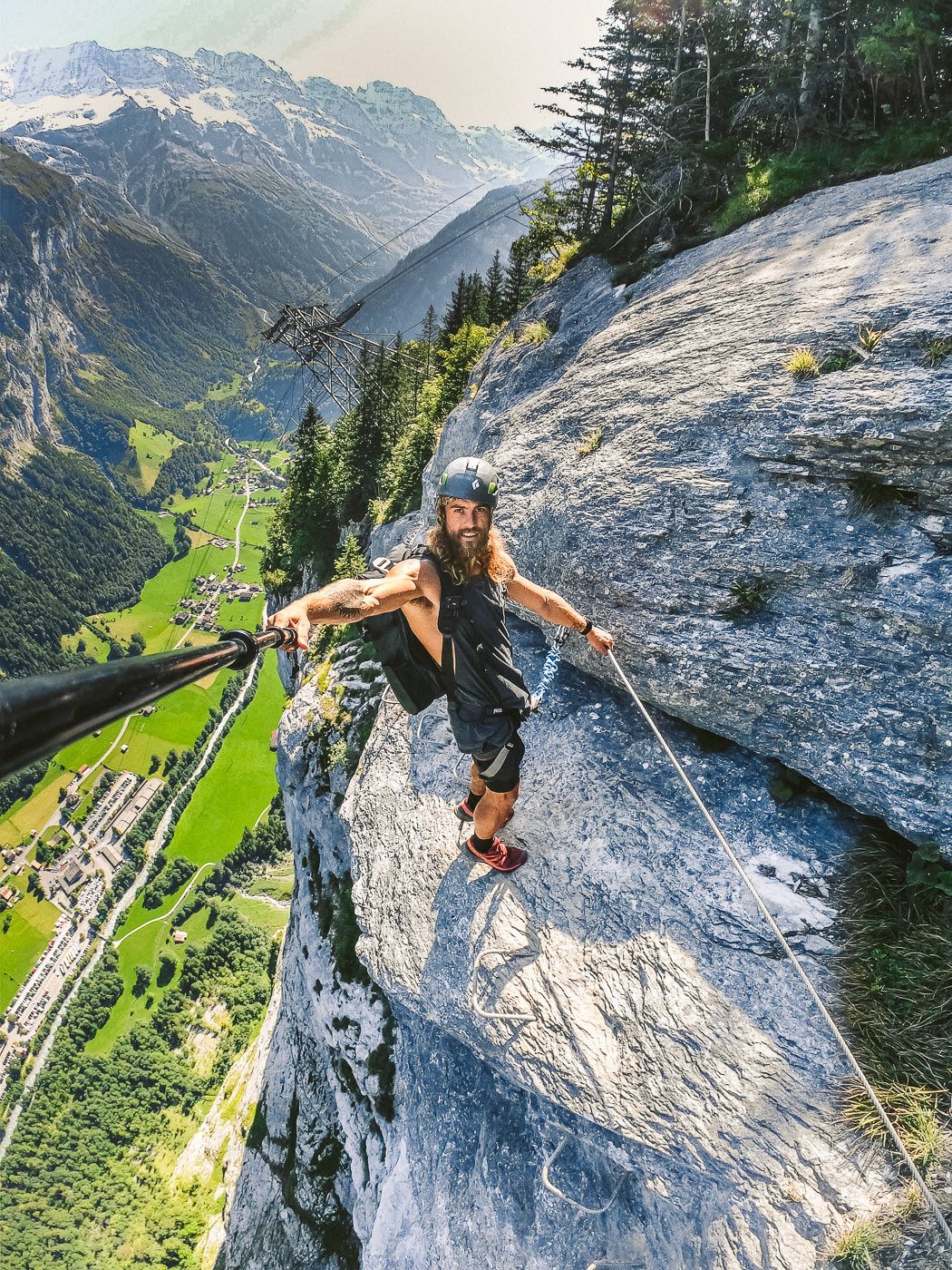
After about 15-minutes, we began to pass alongside some cool caves and other rock formations before finally, we reached some exposure. The highlight of the Via Ferrata is surely the cliff-edge traverse over Lauterbrunnen early on in the trail. Here you are hanging fully over the edge, inching your way along on small metal rungs. It’s a fear-factor moment and was definitely an epic little section as you toe your way across while hundred meters above the valley.
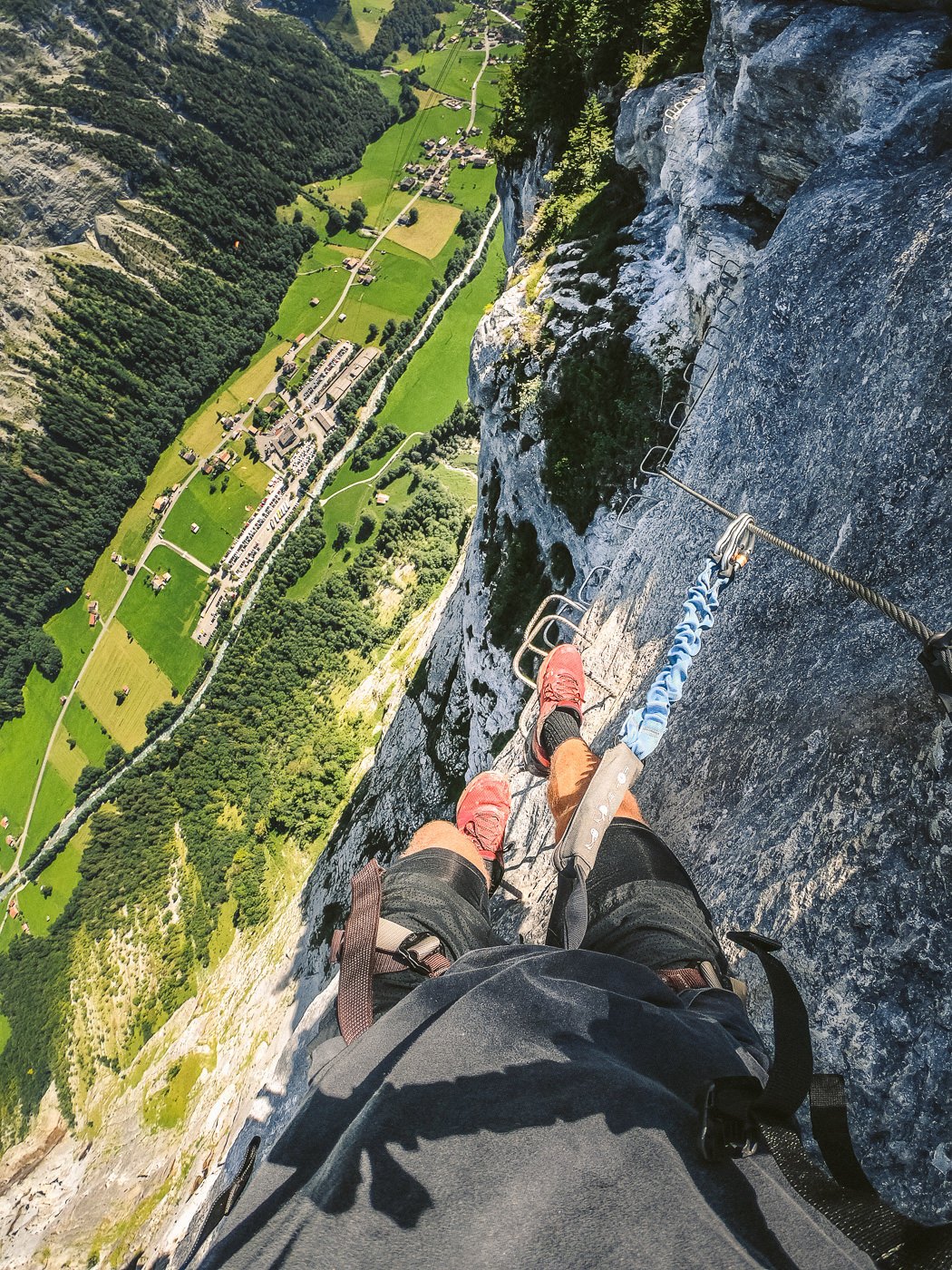
The next section was a cable tightrope above a waterfall. You did have two cables to hold onto but you needed to balance yourself on the single cable as you walked your way across the waterfall. You can check that one out in the vlog I posted below. I’d never seen this type of via ferrata at the others I had tried so it was cool to see a new style of cable introduced in this one.
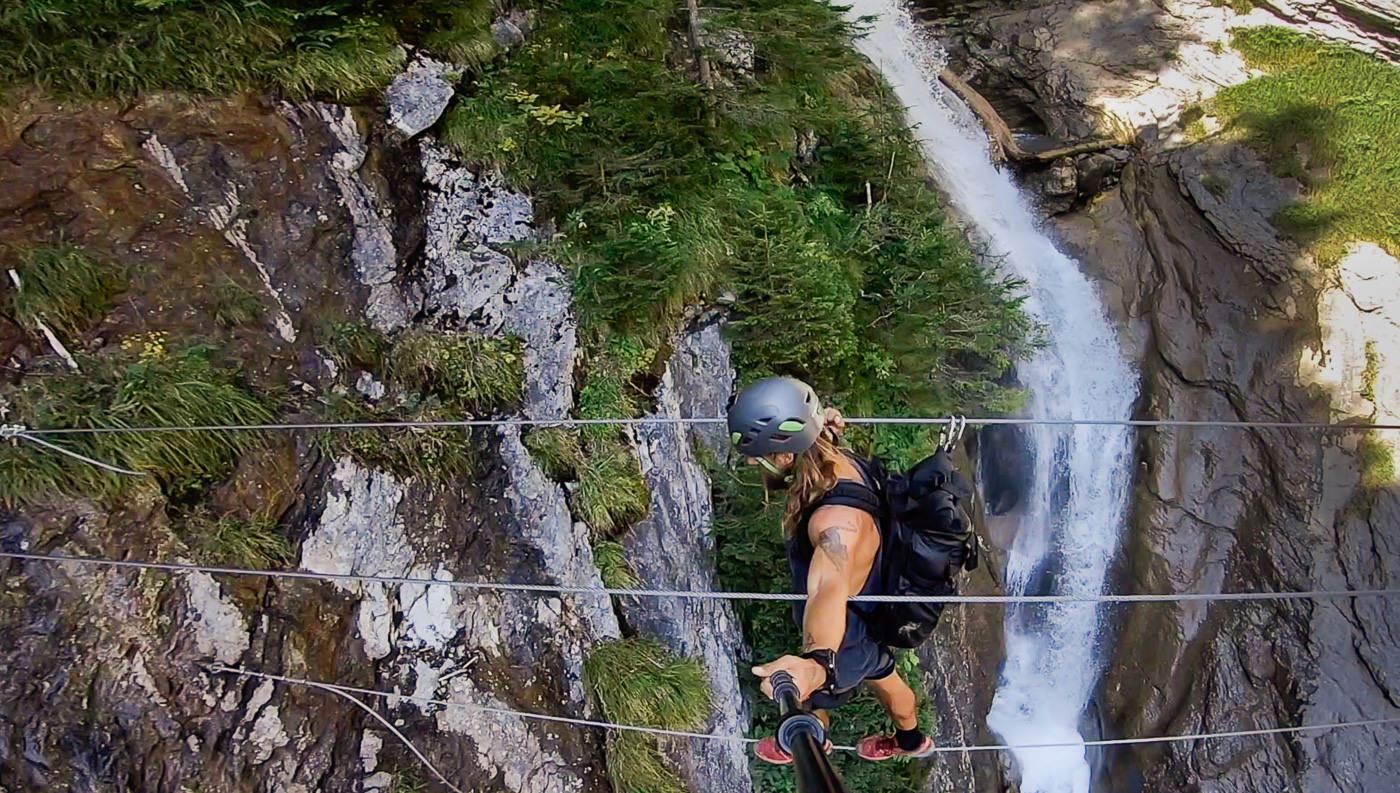
The trail now headed into the forest for a while and I actually unclipped for a bit as it was truly just a hike. However, the drop-off is still there and still big so stay clipped in would be my advice. Next up were some vertical ladders.
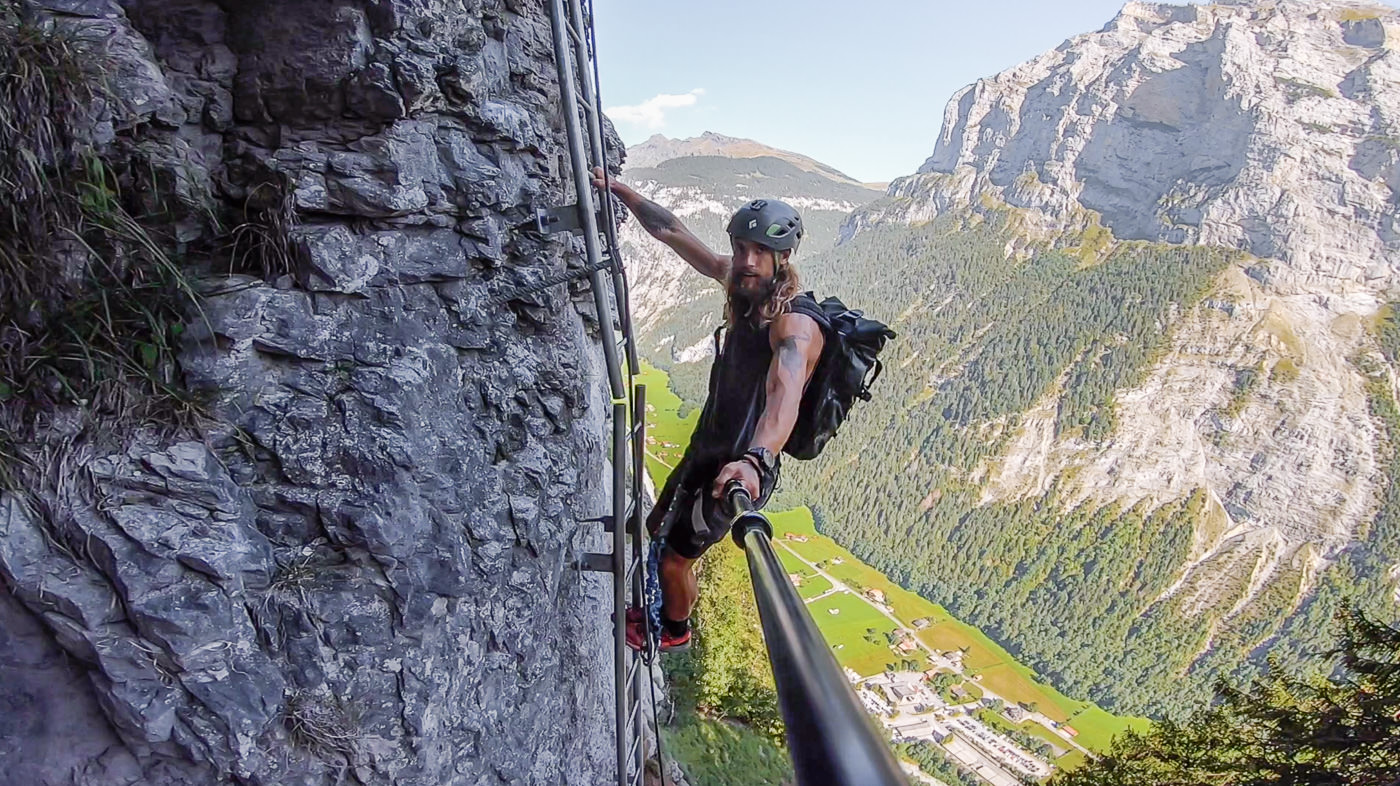
These were actually quite physically demanding, especially doing them with one hand as I filmed the whole thing! Again, you have views down into Lauterbrunnen while on these ladders and they are a great photo spot. Many of these photos are simply screenshots from the GoPro video I recorded.
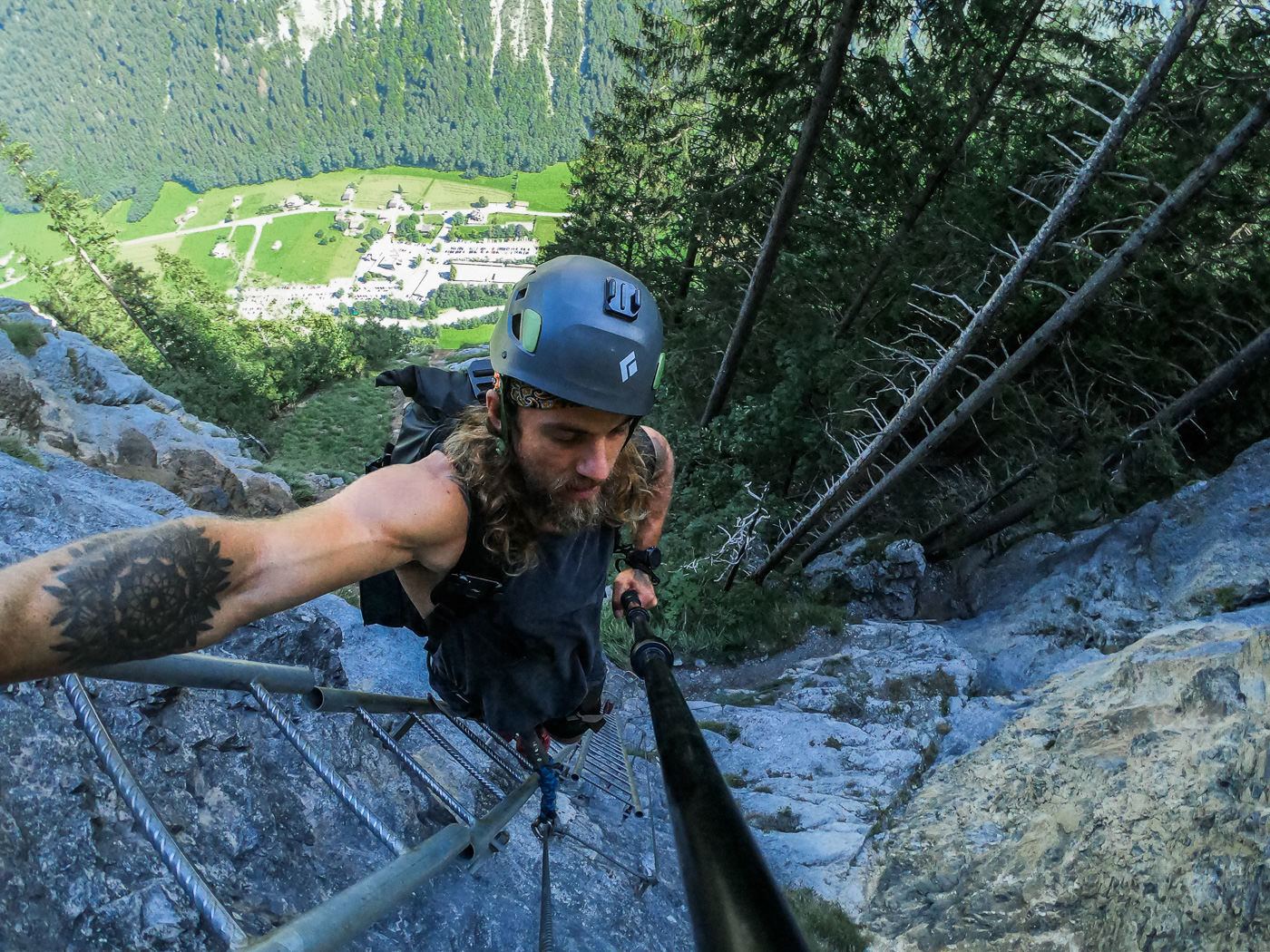
After the ladders, we again dove into the forest for more easy trail navigating before finding one more little cable tight-rope over a waterfall. There were quite a few waterfalls on this trail, which was really nice and the whole landscape was just incredible. Waterfalls, cliff-edges, and views of Lauterbrunnen. What more can you ask for?
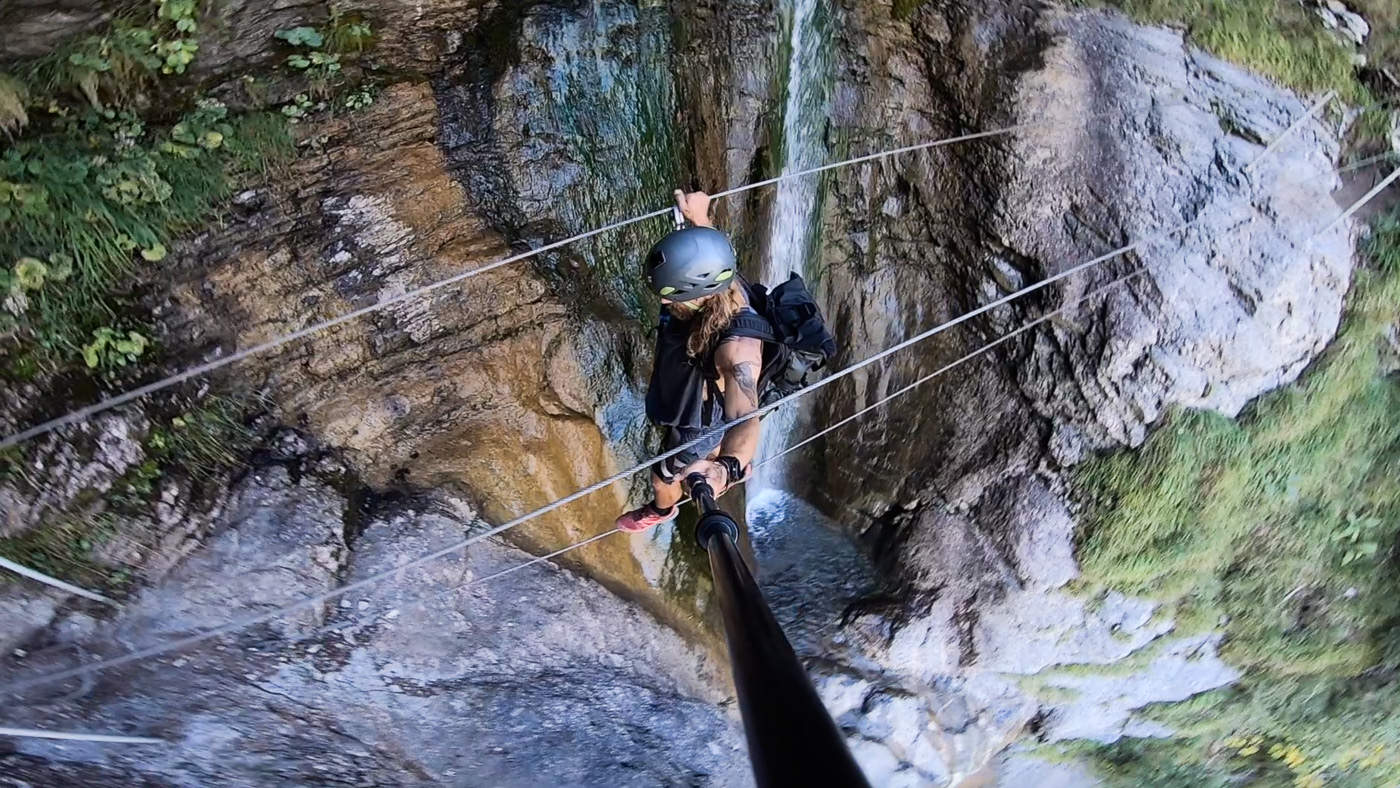
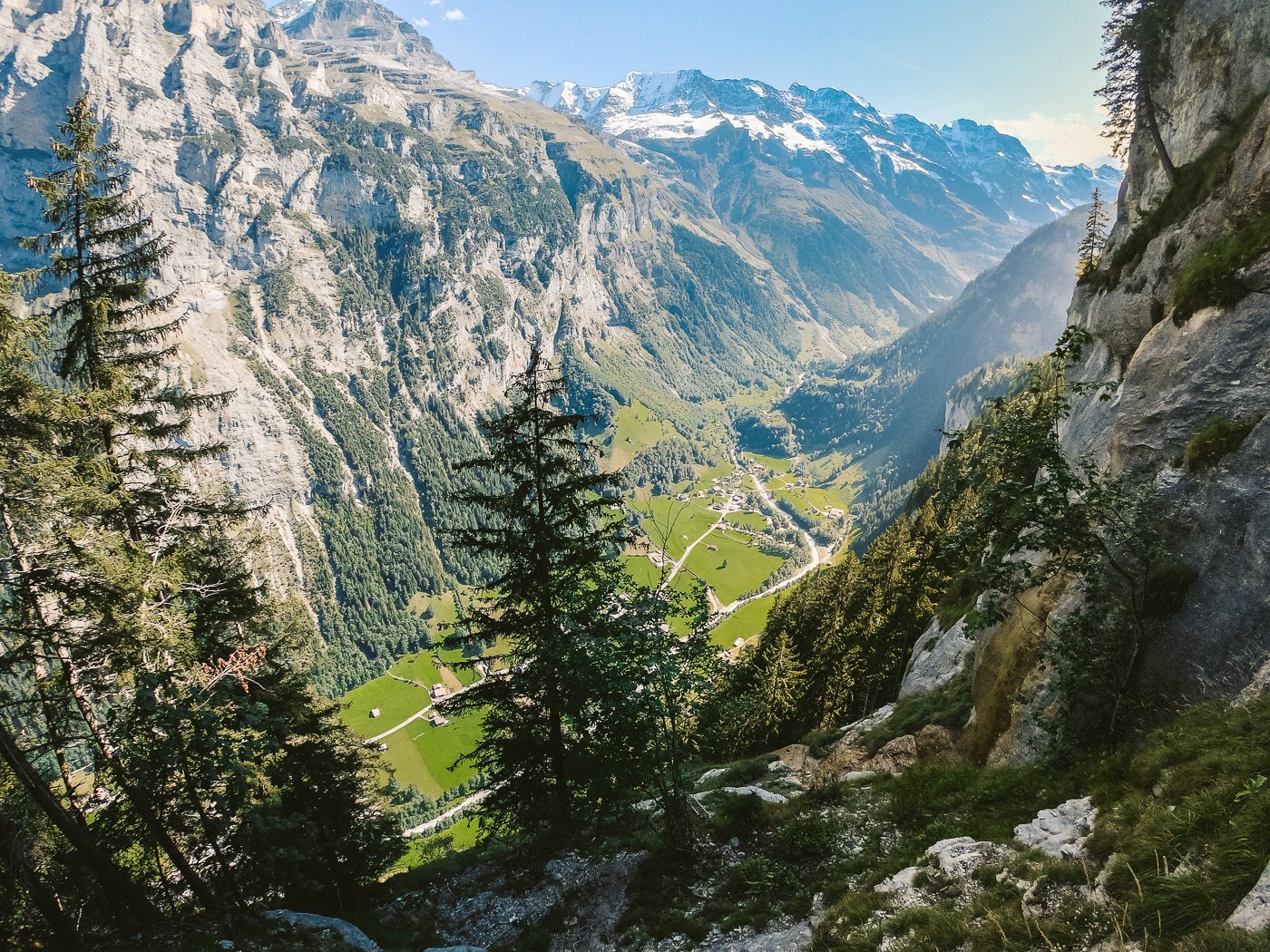
The final part of the course is quite spectacular. It is the suspension bridge. I initially thought this would be quite simple and was even planning to run across but of course, the sections are only a few meters at a time and it is very wobbly.
This will be quite a scary part if you are afraid of heights because the bridge is shaking a lot! Because you hook in every 10 steps, it is very safe and you can enjoy the danger from the comfort of your harness.
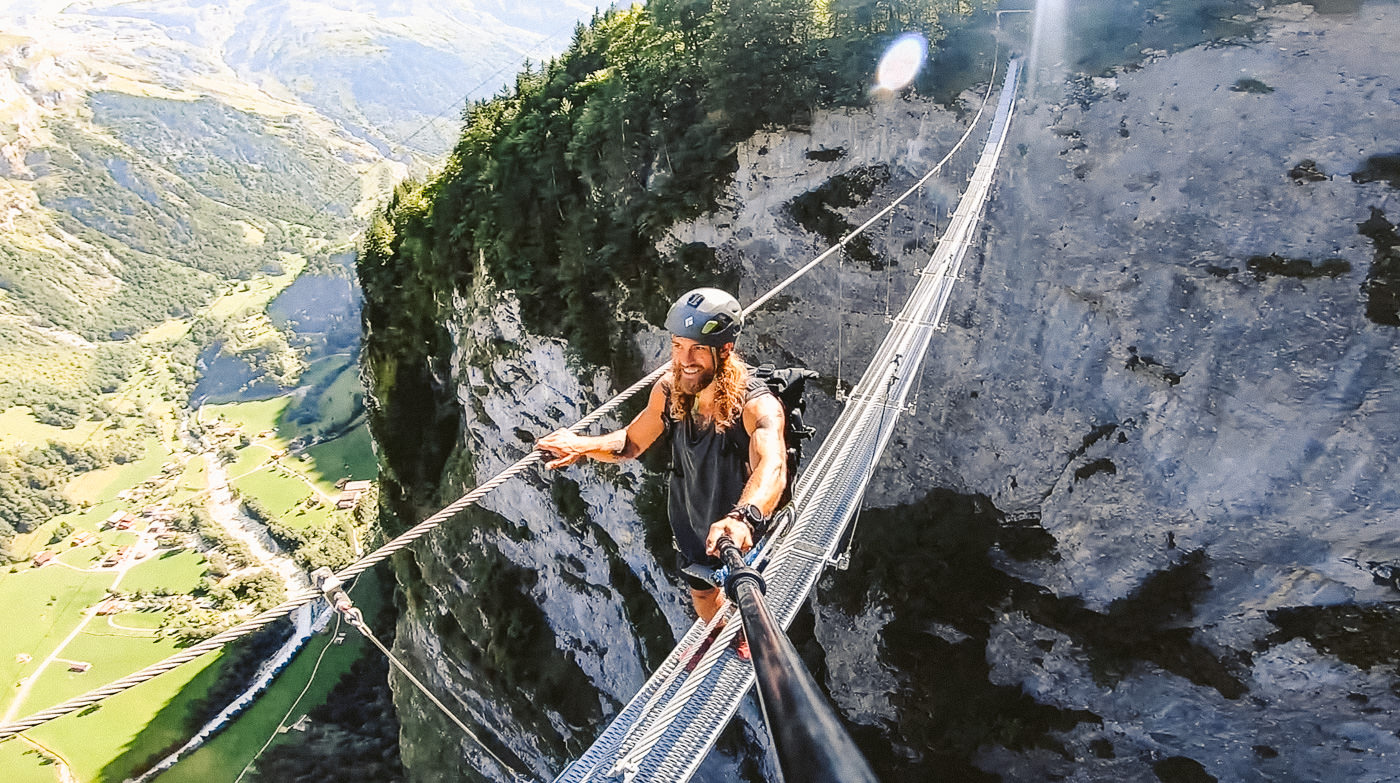
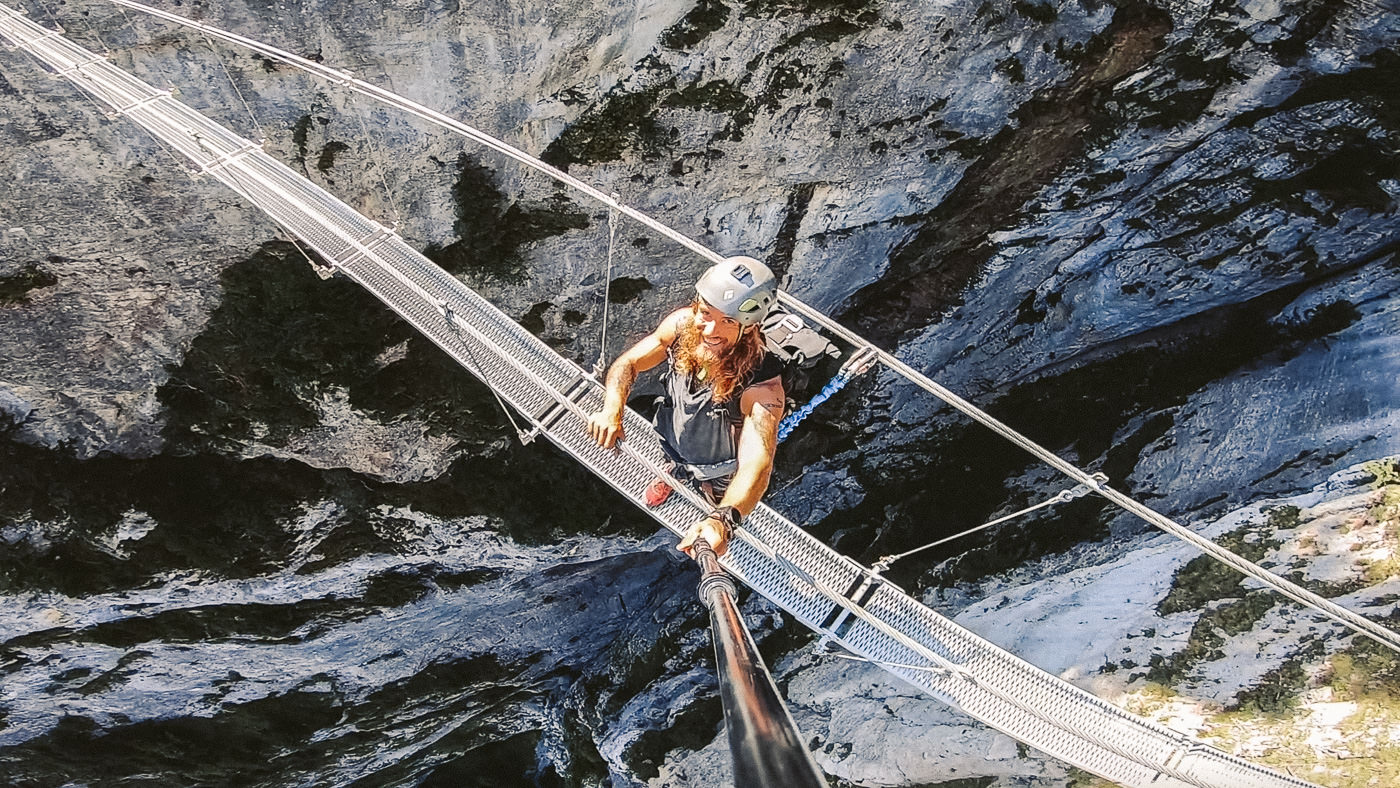
THINGS TO KNOW ABOUT THE MÜRREN VIA FERRATA
- Car-Free Village: Mürren, the starting point of the Via Ferrata, is a car-free village, one of the few left in Switzerland. This unique characteristic adds to the charm of the journey, giving climbers an opportunity to experience Swiss mountain life as it once was.
- Highest Suspension Bridge in Europe: One of the highlights of the route is the “Nepal Bridge”, considered the highest suspension bridge in Europe. Crossing this bridge is an exhilarating experience with an unparalleled panoramic view of the Swiss Alps.
- Iconic Peaks: The trail offers stunning views of some of the most famous peaks in the Alps: Eiger, Mönch, and Jungfrau. On a clear day, climbers can enjoy uninterrupted views of these majestic mountains.
- Diversity of the Route: The Mürren Via Ferrata has a varied route that includes vertical rock faces, narrow paths, wooden walkways, and cable bridges. The variety of terrains enhances the uniqueness and excitement of the journey.
- Access to Untouched Nature: Gimmelwald, where the trail ends, is a tiny, untouched hamlet that feels frozen in time. It’s one of the last authentic Swiss mountain villages and offers a peaceful conclusion to the high-adrenaline journey of the Via Ferrata.
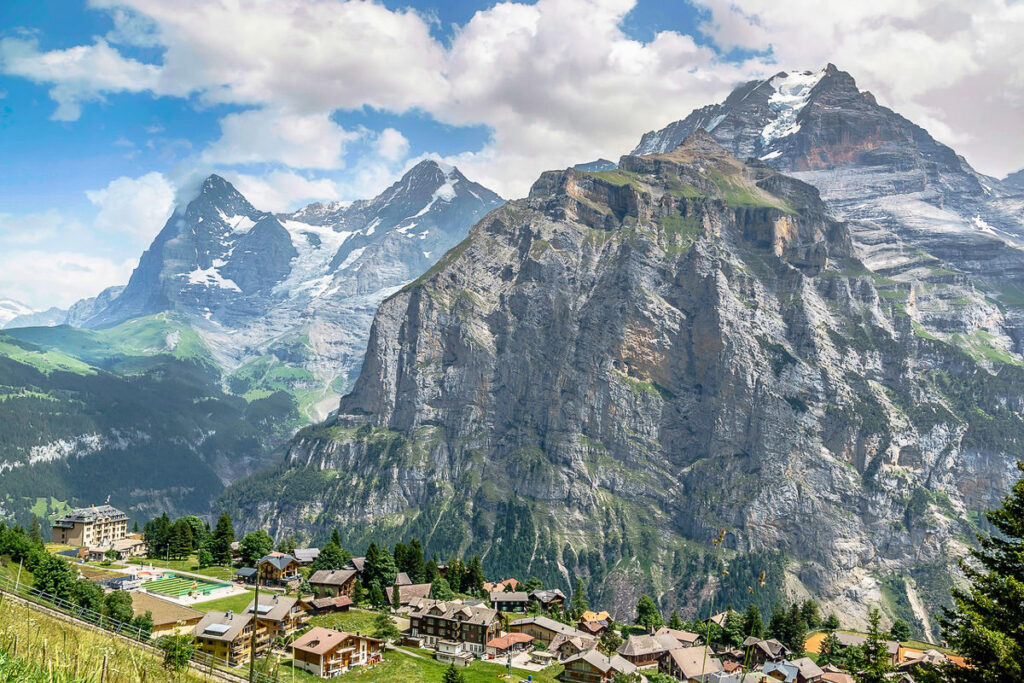
BEST TIME OF YEAR TO DO THE MÜRREN VIA FERRATA
The best time of year to do the Mürren Via Ferrata in Switzerland is typically during the summer and early autumn months, from June through October. The weather during this period is usually favorable, with warmer temperatures and less chance of snow, making the journey safer and more enjoyable.
During the summer, the trails are clear of snow, the daylight hours are longer, and the Alpine meadows are in full bloom, enhancing the already beautiful scenery. Early autumn also offers the charm of fall foliage, as the leaves change to vibrant shades of orange and red.
However, weather in the mountains can be unpredictable and conditions can change rapidly, so it’s always essential to check the local weather forecast and trail conditions before embarking on the Via Ferrata. It’s also recommended to start early in the day to maximize daylight and avoid afternoon thunderstorms which can occur during the summer months.
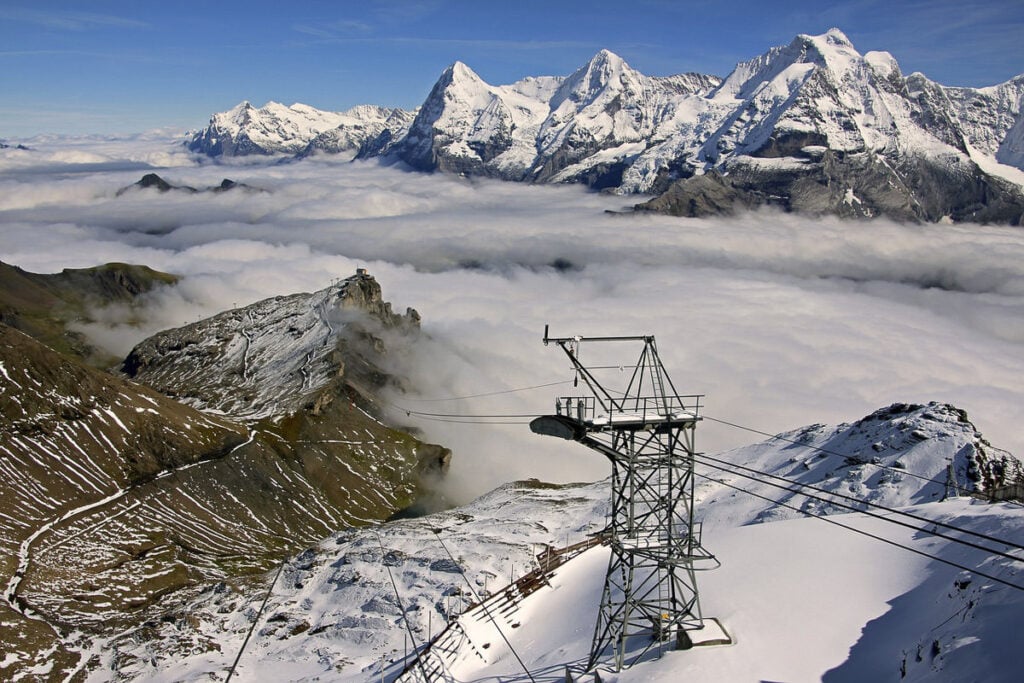
I hope you enjoyed this guide for the Murren to Gimmelwald Via Ferrata in Switzerland.
SWISS TRAVEL PASS or HALF-FARE CARD
OPTION 1: Buy the Swiss Half Fare Card: Switzerland trains, buses, and cable cars are EXPENSIVE! I found the best way to get around cheaply was to buy the Swiss Half-Fare Card before I arrived. It gives you 50% off every regular train, bus, and even many cable cars. It only costs $150 USD but pays itself off in just a few days with many train tickets in Switzerland costing close to $100 alone. If you are staying for more than 5 days, I suggest buying the Swiss Half-Fare Card.
OPTION 2: Buy the Swiss Travel Pass: The second option is to get the Swiss Travel Pass, which gives you unlimited train, bus, and (many) cable car rides but it’s pretty expensive at around $100 USD per day so if you don’t travel each day it isn’t worth it.
OPTION 3: Buy the FLEXI Swiss Travel Pass: The final (BEST) option is to get the FLEXI Swiss Travel Pass, which allows you to buy 8 days’ worth of transit but you can choose the night before if you want to activate the next day. That way you don’t need to travel every day to get your money’s worth, you can just activate the FLEXI Swiss Travel Pass on the days when you are doing sizeable transits. My advice is to book the Swiss Half-Fare Card or the FLEXI Swiss Travel Pass in advance before your trip so it’s ready to go when you arrive.
GET A SWISS TRAVEL PASS!
Enjoy UNLIMITED train, boat, and bus rides in Switzerland for up to 15 days. Click to book a flex Swiss Travel Pass or choose the Consecutive Swiss Travel Pass.
The Swiss Travel Pass starts at $260 for 3 days. Click here to check if it’s available on your travel dates.
MY SWITZERLAND HIKING GUIDES
I spent 100 days hiking in Switzerland and created a guide for different regions around the country. You can click on one of my Switzerland hiking guides below to help you plan your trip.
- The Complete Guide: 50 AWESOME HIKES IN IN SWITZERLAND
- The Via Ferrata Guide: 4 EPIC SWITZERLAND VIA FERRATA COURSES
- Lauterbrunnen Guide: 10 AWESOME HIKES NEAR LAUTERBRUNNEN
- Interlaken Guide: 15 AWESOME HIKES IN INTERLAKEN
- Grindelwald Guide: 12 AWESOME HIKES NEAR GRINDELWALD:
- Mürren Guide: 7 AWESOME HIKES IN MURREN
- Appenzell Guide: 9 AWESOME HIKES NEAR APPENZELL
- Chur Guide: 7 AWESOME HIKES NEAR CHUR
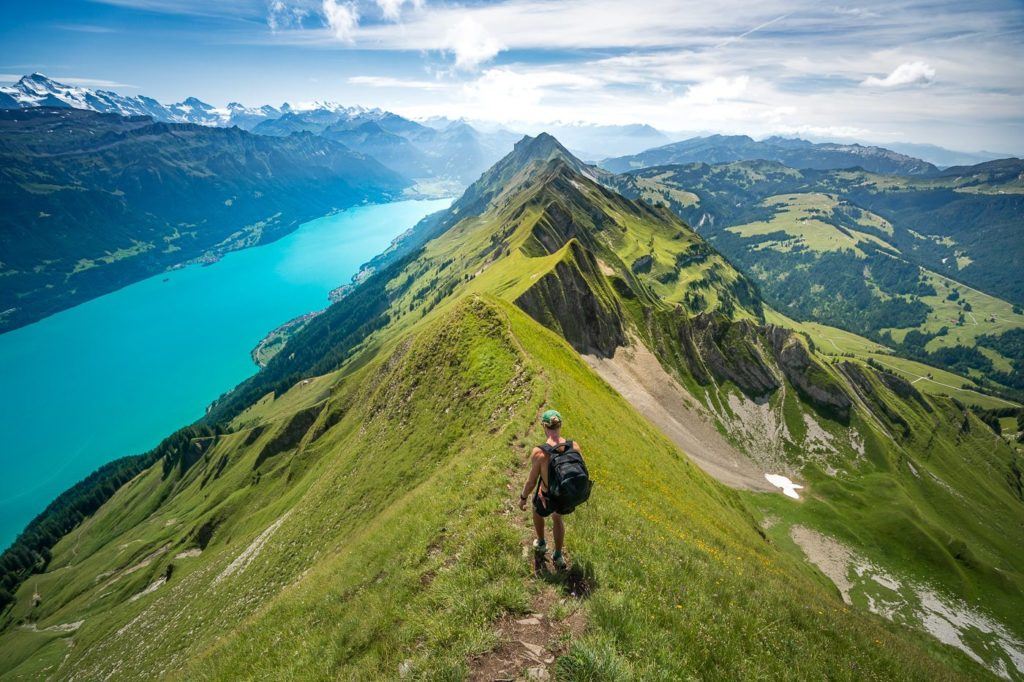
MY SWITZERLAND TRAVEL TIPS
- For Backpackers: SWITZERLAND BUDGET BACKPACKING GUIDE
- Travel Tips: 20 THINGS TO KNOW BEFORE VISITING SWITZERLAND
- Transport Tips: RENTING AND DRIVING A CAR IN SWITZERLAND
- Accommodation Guide: 30 BEST PLACES TO STAY IN SWITZERLAND
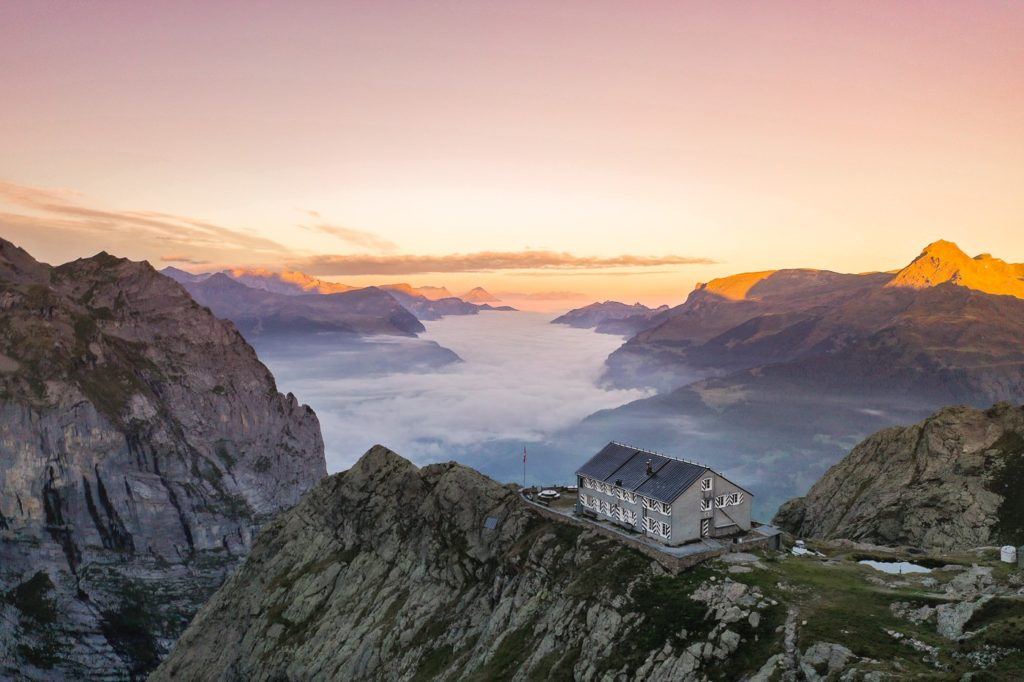

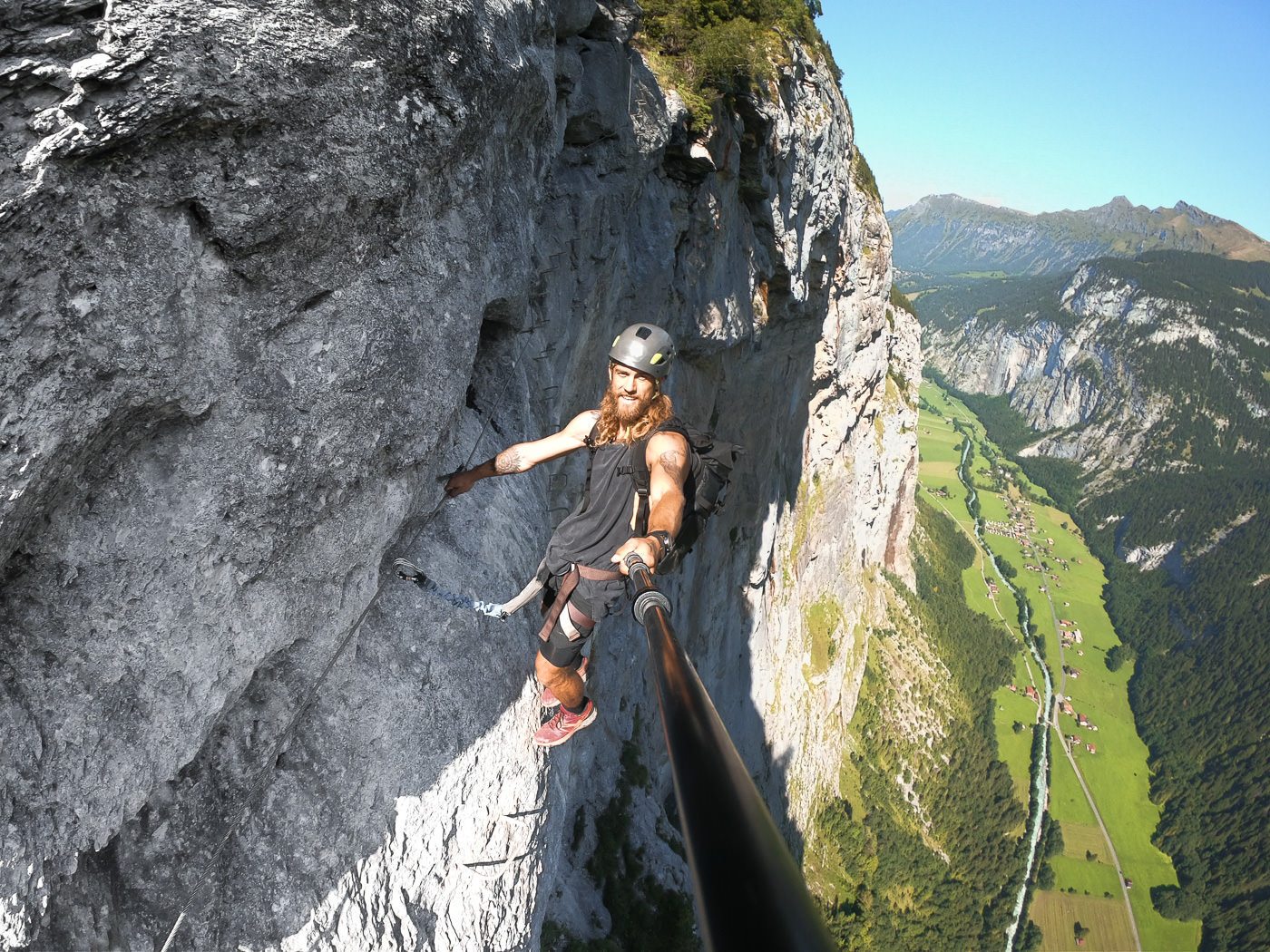
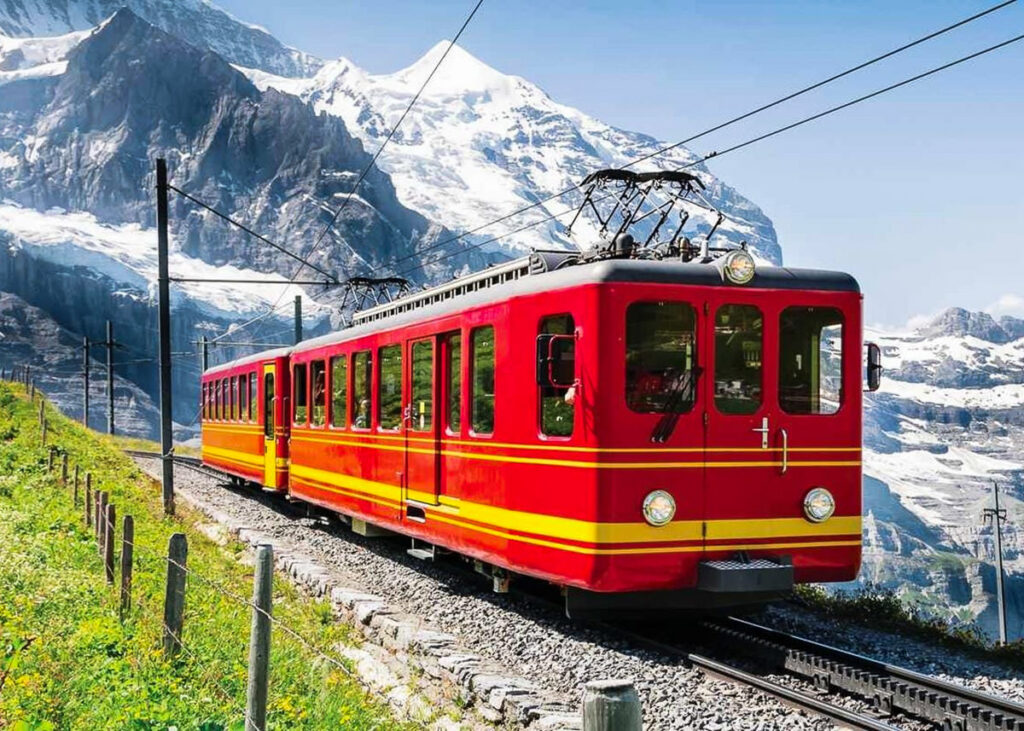
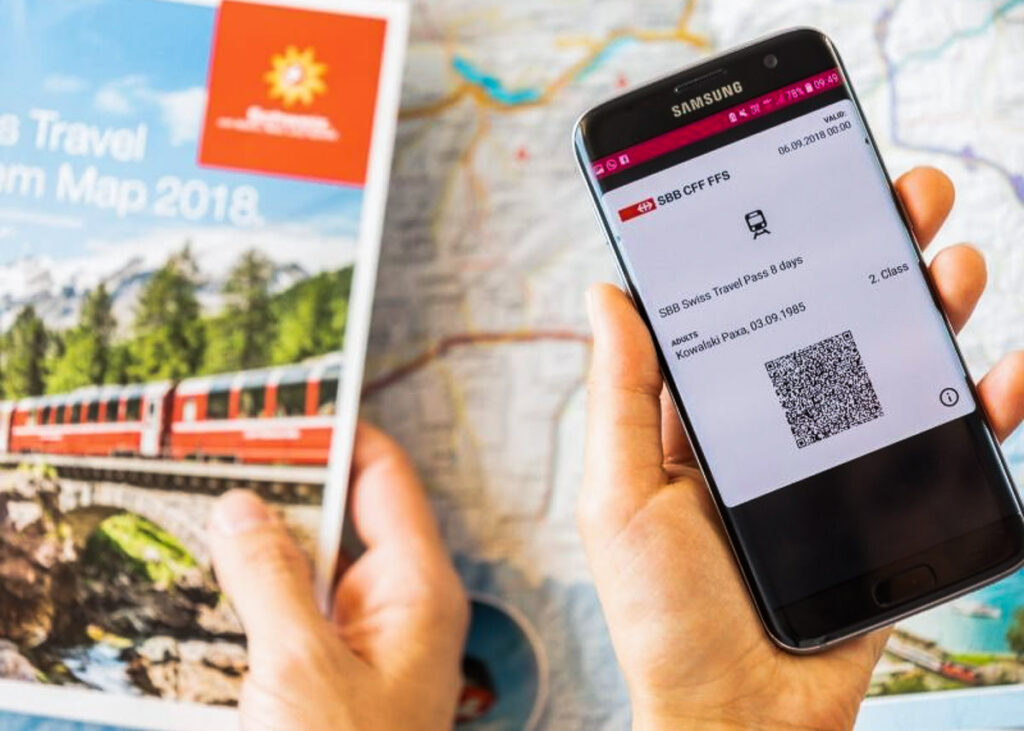
Juras
Saturday 17th of August 2024
I did this via ferrata last week and I was verry dissapointed. Actualy 80% of this ferrata goes in the forest and feels like a hike. There are just few and short interesting sections and you posted photos of every singe beutifull point, there is nothing more. You should mention that Murren ferata can be intersting if it is just Your first via feratta and you want to check are you OK on short sections of exposure? There are lots of more beautifull and interesting via ferratas in Switzerland (Kandersteg, Jegihorn, Daubehorn...).
Eric Wakeling
Monday 10th of July 2023
I just wanted to say that this post is pretty epic. I'll be staying in Wengen for three nights in about a month and I'm seriously considering doing this.
So this is just a massive appreciation comment - really great content. Thanks!
Jim
Thursday 3rd of September 2020
Hello,
My family will be in Lauterbrunnen in October. My kids, twins age 8, have climbed since they were four indoors and I am an experienced climber myself. Are there age restrictions on the via ferrata? What are your thoughts on kids doing it with supervision?
Jackson
Thursday 3rd of September 2020
Hey! I actually saw a young kid on the via ferrata. They had an extra cord attached to the parent so they were attached to the via ferrata cable and also the parent. There are a few sections as you can see from the photos that would be pretty hard to completely help them through it and I imagine there are some parts they would have to do alone even if you are right next to them. Having said that, skill is not an age and I'm sure many 8-year olds are better climbers and better at via ferrata than me so try and watch my video and see if the hardest parts look manageable for your kids based on their experience :) Enjoy and stay safe.
Jack Gordon
Wednesday 15th of July 2020
Hey mate, doing this via ferreta next week, what camera did you use for the photo of your feet on the steps on the cliff overhang?
Jackson
Friday 17th of July 2020
Hey Jack! I used a GoPro 7 on a long selfie stick for all of the shots on this hike.